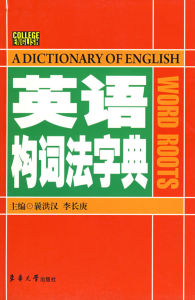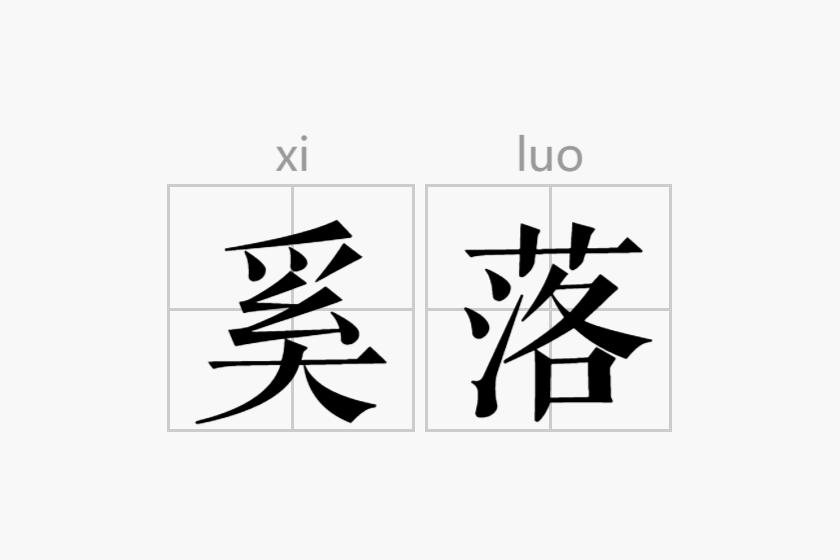构词法(词形学术语)

构词法
词形学术语
语言是随着人类社会的不断发展而发展的。一些旧词的过时意味着需要人们创造出一些新的词,而新词的产生,也大体上服从一定规则,有其规律可循。语言的这种“弃旧创新”不断完善和发展的过程体现出的就是一种规律——构词法(word-formation)。
| 中文名 | 构词法 |
| 英文名 | Morphology |
| 领域 | 词形学 |
| 方式 | 合成法,转化法,派生法 |
基本概述
英语中的词分两大类:开放性词类(open class),主要包括名词、动词、形容词和副词,因为这些词类总有新词增加。介词、代词、冠词、指示词、连词等被称为封闭性词类(closed class)。
转化法
转化法就是一个词项不用加后缀就成为或转化为新词类的派生方法(Quirk et al 1985)。以动词 attack 为例 (例如The enemy attacked us at night),它和名词attack(例如The enemy launched an attack on us at night)的词形相同;名词attack就被看作是由动词attack转化生成的。在描述词与词之间的转化时,由于没附加后缀用来作为依据,决定哪个词项应被看作是词根或是派生形式有一定的困难。通常我们把抽象名词和施动者名词看作是派生名词(例如:desire, answer, walk 等)。用转化法产生的词主要是名词、形容词和动词。
名词转化成动词
 构词法
构词法词转化成动词是现代英语转化法中构词力最活跃的方法之一,现从语义角度将这类词分为以下几种(Quirk et al 1985)。
a.V表示“把…放在N所指的位置”。例如:
--The corridor was carpeted.(在…铺了地毯)
--This factory cans fish to be sent abroad. 把…装罐)
--The newspapers headlined his long record of accomplishments.(把…当作头条新闻报道)
--After the tiger was caught, it was caged. (把…关在笼子里)
--A team of experts at Columbia is now cataloguing the tapes and indexing the transcripts,
which will be available for scholarly research.哥伦比亚的一批专家正在整理录音资料汇编成目,同时又将其书面材料编成索引,以供学者研 究。
这种用法常见的词还有bottle,corner,floor,garage,position,shelve等。
b. V表示“给予N”
--They sheltered (为…提供住宿)the orphans.
--The sweets are then coated (涂在…上)with chocolate.
--Her eyes were masked (遮盖)by huge sunglasses.
这种用法常见的词还有butter, commission,grease,muzzle,oil,plaster等。
c. V表示“把N去掉”
--Bill weeded the garden. (除草)
--Would you peel me an apple please? (削皮)
--He fell and skinned his knee. 他摔了一跤,擦破了膝盖的皮。
这种用法常见的词还有core, dust, gut, top-and-tail, 等。
d. V表示“把N所指的对象用作一种与之有具体联系的任何活动的工具”。例如:
--I had to elbow my way through the crowd to have a close look at the goods. (用肘挤)
--She fingered the soft silk.(用手感触)
--He braked the car in vain; the brakes would not hold. (刹车)
这种用法常见的词还有hand, fiddle, glue, knife 等。
e. V表示“充当名词的角色”。这里的名词可以是指人、动物或无生命的物体。例如:
--She mothered the orphan. (母亲般照管…)
--Tom parroted what the boss had said. (鹦鹉学舌…)
--The incident shadowed their meeting. 那次事件给他们的会见蒙上了阴影。
这种用法常见的词还有chaperon, father, nurse, pilot, referee等。
f. V表示“使…变成N”或“使…成为N”
--Please cash this check for me. (把…兑现)
--A government study targets earnings from tourism at $140 million by 1980. (target意为“把… 定为目标”)
--Occupations are grouped into separate categories. (将…形成组)
这种用法常见的词还有knight, cripple等。
g. V表示“用N送/去”
--Will you please mail the parcel? (邮寄)
--My bike is under repair, so I had to bus to the city this morning instead of cycling. (坐车;踩单车)
--Let me motor you to town. (用车运送)
这种用法常见的词还有ship, telegraph, boat, canoe 等。
形容词转化成动词
 构词法
构词法形容词转化为动词可分成两种:一种是形容词用作动词,表达“使…adj”或“成为adj”;另一种是形容词加上一个小品词派生出短语动词。例如:
--The vast amounts of energy now expended in warming our surface surroundings when they are too cold, and cooling them when they are too warm, could be saved. (使…温暖;使… 凉爽)
--Nothing dries sooner than a tear. (变干)
--This is considered an important way of narrowing the gap between the rich and the poor countries. (使…缩小)
--The sea gradually calmed down as we steamed out. (平静下来)
--Slow down before you reach the crossroads. (减速)
--We put him on the bed to sober up. (清醒起来)
动词转化成名词
在现代英语中,由动词形成的名词相对地说数量不大,而且使用范围也不广。从语义角度将这类词分为以下几种(Quirk et al 1985)。
a. 转化生成的N可表示V对应的“状态”(一般为“思想状态” 或“感觉状态”)、“事件/活动”、或“V-ing
的方式”
--He had a desire to be a scientist. (渴望)
--Uncle Jeremy is a man of few wants and is happy with simple pleasures. (需求)
--Her love for him never wavered. (爱)
--The fall from his horse broke his leg. (跌落)
--His act would always get a huge laugh. (笑)
--His release was secured by the perseverance of his wife. (释放)
--Refinery owners have already resorted to temporary shutdowns. (停工)
--I can always recognize her by her walk. (走路的样子)
表示“状态”常见的词还有dismay, doubt, smell, taste等;表示“事件/活动”常见的词还有attempt, hit, laugh, search, swim, walk-out, blow-out (of a tyre);表示“V-ing的方式”常见的词还有throw和 lie。
b. 转化生成的N可表示V的宾语、主语、工具、地点等。
--I made a great find in an old bookshop yesterday. (发现,指买到难得的书)
--Several good takes were ruined by the surge of children into our working area. (take指的是被拍摄的镜头)
--We said that we wouldn’t be relying on handouts from anyone for our future.(施舍物)
--Stop being a bore. (惹人厌烦的人或物)
--He looks like a tramp. (流浪汉)
--That boy is a sneak — he told the teacher what I had done. (告密生)
--The cloth is a good cover for the table. (罩子)
--There is no cure for the common cold. (特效药物)
--Use brown polish on these shoes. (擦亮剂)
--The road is full of sharp turns. (转弯)
--The event became the divide between two eras of Chinese history. (分界线)
--In this mountain retreat I would find the best climate in the country. (休养所)
表示V的宾语常见的词还有answer, bet, catch等。表示V的主语常见的词还有a cheat(骗子), a sneak(鬼鬼祟祟的人), a coach(教练员), a good kick(足球踢得很好的人), a crack shot(神枪手)等。表示V的工具常见的词还有paper, wrap, wrench等。表示V的地点常见的词还有rise, lay-by, drive-in等。
值得注意的是,有些动词加上词缀可派生为名词,例如repeatàrepetition,removeàremoval等,这时它们和由转化法生成的名词形成一对同源、同类的词,这对词在意义或文体色彩上会存在着一定的差异,但在意义上也会发生交叉现象,在使用中要注意区分。例如:repeat多指重演、重播、重奏或重唱的部分,在口语中可作“重复”解;而repetition常作“重复”解。remove和removal均可作“移动”“搬家”讲,但removal还有“解职”“排除”“切除”的意义,remove可作“学校中的升级”“程度”“阶段”讲。command为“指挥”“指令”;commandment为“戒律”“圣训”。Combine为“联合企业”“联合收割机”;combination为“联合”“结合体”。Exhaust为“排除的气”“排气装置”;exhaustion为“筋疲力尽”。divide多指“分水岭”“分界线”;division则指“分开”“分歧”“分派”,但divide也可作“分歧”解,division也可作“分界线”解。从上面的叙述中我们可以看出转化法所具有的活跃的构词能力。正因为如此,转化法是一种异常重要的构词方式。
派生法
在词根前面加前缀或在词根后面加后缀构成一个与原单词意义相近或截然相反的新词叫作派生法。
前缀
除少数前缀外,前缀一般改变单词的意义,不改变词性;后缀一般改变词类,而不引起词义的变化。
1.表示否定意义的前缀常用的有dis-,il-,im-,in-,ir-,mis-,non-,un-等,在单词的前面加这类前缀常构成与该词意义相反的新词。例如:
appear出现→disappear消失
correct正确的→incorrect不正确的
lead带领→mislead领错
stop停下→non-stop不停
possible可能的→impossible不可能的
2.表示其他意义的前缀常用的有a-(多构成表语形容词),anti- (反对;抵抗),auto- (自动),co- (共同),en- (使),inter- (互相),re- (再;又),sub- (下面的;次;小),tele- (强调距离)等。例如:
alone单独的anti-gas防毒气的
auto-chart自动图表
cooperate合作enjoy使高兴
internet互联网reuse再用
subway地铁telephone电话
3.改变词性的前缀有:en-,de-,be-,a-,out等。
(1)en-
该前缀通常加在形容词或名词前构成动词,例如:
large(形容词,大的)→enlarge(动词,扩大)
courage(名词,勇气)→encourage(动词,鼓励)
(2)de-
该前缀通常加在名词之前构成动词,其意义大多和原名词相反。例如:
value(名词,价值)→devalue(动词,降低…的价值)
(3)be-
该前缀可加在名词或形容词前构成动词。例如:
friend(名词,朋友)→befriend(动词,与…交朋友)
little(形容词,小的)→belittle(动词,轻视)
(4)a-
这个是构词力较强的前缀。常加在名词或描述性动词之前,构成形容词或副词。例如:
board(名词,甲板)→aboard(副词,在船上)
side(名词,旁边)→aside(副词,在旁边)
sleep(动词,睡觉)→asleep(形容词,睡着的)
(5)out-
①可加在名词之前构成形容词。例如:
door(名词,门)→outdoor(形容词,户外的)
②可加在动词之前构成名词。例如:
break(动词,打破)→outbreak(名词,爆发)
注意:英语中的前缀in-,un-通常表示“不”或“…的相反”的含义,因此由其构成的派生词一般具有否定的意义。然而,有些由这两个前缀构成的派生词并非有否定的意义,而与词根同义或近义。著名学者周海中教授在《in-,un-不一定表示“否定”》一文中就举了若干个例子,如:coming/incoming(来到),habit/inhabit(居住于),loose/unloose(解开,释放),rip/unrip(撕开)等。这类派生词虽然不多,但值得注意,勿望词生义。
后缀
英语单词不仅可以通过加前缀构成新词,也可加后缀构成新词。后缀通常会改变单词的词性,构成意义相近的其他词性;少数后缀还会改变词义,变为与原来词义相反的新词。
(1)构成名词的后缀常用的有-ence,-(e)r/ -or (从事某事的人),-ese (某地人),-ess (雌性),-ian (精通……的人),-ist (专业人员),-ment (性质;状态),-ness (性质;状态),-tion(动作;过程)等。例如:
differ不同于→difference区别
write写→writer作家
Japan日本→Japanese日本人
act表演→actress女演员
music音乐→musician音乐家
(2)构成动词的后缀常用的有-(e)n (多用于形容词之后),-fy (使……化),-ize (使……成为)。例如:
wide→widen加宽
beauty→beautify美化
pure→purify提纯
real→realize意识到
organ→organize组织
(3)构成形容词的后缀常用的有-al,
-able (有能力的),-(a)n(某国人的),-en (多用于表示材料的名词后),-ern (方向的),-ese(某国人的),-ful,-(ic)al,-ish,-ive,-less (表示否定),-like (像……的),-ly,-ous,-some,-y (表示天气)等。例如:
nature自然→natural自然的
reason道理→reasonable有道理的
America美国→American美国的
China中国→Chinese中国人的
gold金子→golden金的
east东→eastern东方的
child孩子→childish孩子气的
snow雪→snowy雪的
(4)构成副词的常用后缀有-ly(主要用于形容词之后表示方式或程度),-ward(s)(主要用于表示方位的词之后表示方向)。例如:
angry生气的→angrily生气地
to到→towards朝……,向……
east东方→eastward向东
(5)构成数词的后缀有-teen(十几),-ty(几十),-th(构成序数词)。例如:
six六→sixteen十六→sixteenth第十六
four四→forty四十→fortieth第四十
合成法
合成名词
构成方式例词
名词+名词weekend周末
名词+动词daybreak黎明
名词+动名词handwriting书法
名词+及物动词+er/or pain-killer止痛药
名词+介词+名词editor-in-chief总编辑
代词+名词she-wolf母狼
动词+名词typewriter打字机
动名词+名词reading-room阅览室
现在分词+名词flying-fish飞鱼
形容词+名词gentleman绅士
副词+动词outbreak爆发
介词+名词afternoon下午
合成形容词
名词+形容词snow-white雪白的
名词+现在分词English-speaking讲英语的
名词+to+名词face-to-face面对面的
名词+过去分词man-made人造的
数词+名词one-way单行的
数词+名词+形容词two-year-old两岁的
数词+名词+ed five-storeyed五层的
动词+副词see-through透明的
形容词+名词high-class高级的
形容词+名词+ed noble-minded高尚的
形容词+形容词light-blue浅蓝色的
形容词+现在分词good-looking相貌好看的
副词+形容词ever-green常青的
副词+现在分词hard-working勤劳的
副词+过去分词well-known著名的
副词+名词fast-food专门提供快餐服务的
介词+名词downhill下坡的
合成动词
名词+动词sleep-walk梦游
形容词+动词white-wash粉刷
副词+动词overthrow推翻
合成副词
形容词+名词hotfoot匆忙地
形容词+副词everywhere到处
副词+副词however尽管如此
介词+名词beforehand事先
介词+副词forever永远
合成代词
代词宾格+self herself她自己
物主代词+self myself我自己
形容词+名词anything任何东西
合成介词
副词+名词inside在……里面
介词+副词within在……之内
副词+介词into进入
截短法
截短法,即将单词缩写,词义和词性保持不变,主要有截头、去尾、截头去尾等形式。
截头
telephone→phone
airplane→plane
omnibus→bus
去尾
mathematics→maths
cooperate→coop
examination→exam
kilogram→kilo
laboratory→lab
taxicab→taxi
截头去尾
influenza→flu
refrigerator→fridge
prescription→script
缩略法
在英语中,我们区分三种构词力十分强的缩略方法:首字母拼音法(acronym)、截成法(clipping)和混成法(blending)。非正式是它们共同的色彩。
首字母拼音法(acronym)
首字母缩略词是由构成一个名称的单词的开首字母合成的。这种构词的方法主要用于组织的名称(例如:EEC = European Economic Community欧洲经济共同体),机械装置或武器(例如:SLV = satellite launch vehicle发射人造卫星的运载火箭),专业用语(例如:ESP = English for Special Purposes特殊用途英语),一类人、职称或头衔(例如:CEO = chief executive officer总经理),替代上文已提到的完整词或词组。首字母缩略词有以下两种发音方式:
a. 按各个开首字母发音。例如:
--C.O.D. cash on delivery (货到即付)
--DIY do-it-yourself (自己动手)
--IOC International Olympic Committee (国际奥委会)
--IMF International Monetary Fund (国际货币基金组织)
--FBI Federal Bureau of Investigation (联邦调查局)
--MIT Massachusetts Institute of Technology (麻省理工大学)
b. 按拼音方法读音,把首字母缩略词看做一个单词。例如:
--SALT Strategic Arms Limitation Talks (限制战略武器会谈)
--NATO North Atlantic Treaty Organization (北大西洋公约组织)
--Laser lightwave amplification by stimulated emission of radiation (激光)
--UNESCO the United Nations Educational Scientific and Cultural Organization (联合国教科文组织)
--WASP White Anglo-Saxon Protestant (盎格鲁-萨克逊裔的清教徒白人)
其他方法
混合法
(混成法)
混合法,即将两个词混合或各取一部分紧缩而成一个新词。后半部分表示主体;前半部分表示属性。
news broadcast→newscast新闻广播
television broadcast→telecast电视播送
smoke and fog→smog烟雾
helicopter airport→heliport直升飞机场
首尾缩略
首尾字母缩略法,即用单词首尾字母组成一个新词。读音主要有两种形式,即各字母分别读音;作为一个单词读音。
very important person→VIP (读字母音)要人;大人物
television→TV (读字母音)电视
Testing of English as a Foreign Language→TOEFL托福
Nato
截成法(clipping)特别是在非正式用法中,我们有时会把某些多音节词缩成一个音节,从而产生截成词。截成法一般可分为以下三种(后两种方法都不大常见):
a. 截去词的尾部:ad = advertisement(广告),demo = demonstration(演示), expo = exposition(展览会),pro = professional(专业人员),gents = gentleman’s lavatory (男厕),pub = public house(酒店),stereophonic(立体声)
b. 截去词的首部:phone = telephone(电话),plane = airplane(飞机),chute = parachute (降落伞),copter = helicopter(直升机)
c. 截去词的首部和尾部:flu = influenza(流感),tec = detective(侦探),fridge = refrigerator (冰箱)
缀合法
(affixation)
英语词缀分为前缀和后缀两种。一般来说,前缀只是改变词的意义,但不改变其词类。后缀不仅改变词的意义,而且使单词由一种词类转变为另一种词类。
前缀法
(prefixation)
a. 表示否定的前缀
in-,im-,il-,ir-表示“not”“the converse of”。例如:inefficient (无效率的),infrequent(不频繁的),improper(不合适的),impossible(不可能的),illiterate(无文化的),irregular(不规则的)
non-表示“not”“the lack of”“the opposite of”。例如:nonaggression(不侵犯),nonconductor (绝缘体),nonsense(废话),nonsmoker(不抽烟的人),nonfiction(非小说的散文文学),nonviolent(非暴力的),nonproductive(非生产的),nonexistent(不存在的),nonstop (直达的)un-表示“not”“the converse of”。例如:unpleasant(不愉快的),unemployed (无工作的),unconcerned(漠不关心的),unsuccessfully(不成功的),unhappily (不开心的),undo(复原),unsay(撤回),unload(从…卸下)
b. 表示倒序或否定的前缀
de-表示“reversing the action”。例如:decentralize(使分散),defrost(除霜),desegregate (取消种族隔离),de-escalate(降低)
dis-表示“reversing the action”“not”。例如:disappear(消失),discount(折价),disagreement (不一致),disadvantage(不利),disobey(不服从),disorder(杂乱),djsloyal(不义的)
c. 表示轻蔑的前缀
mal-表示“badly”“bad”。例如:maltreat(虐待),malformed(畸形的),malfunction(故障),malnutrition(营养失调)
mis-表示“wrongly”“astray”。例如:mislead(误导),misbehavior(品行不端),mispronounce (发音错误),misunderstanding(误解),misdeed(错误行径),misprint(误印)
pseudo-表示“false”“imitation”。例如:pseudoclassicism (伪古典主义),pseudograph (伪造文件),pseudomorph (伪形),pseudonym(假名)
d. 表示程度或尺度的前缀
co-表示“joint(ly)”“on equal footing”。例如:co-education(男女合校制的教育),coheir (共同继承人),copilot(副驾驶员),cohabit(同居),cooperate(合作)
mini-表示“little”。例如:minibus(小型巴士),minicab(小型汽车),mini-bar(迷你酒吧)
over-表示“too (much)”。例如:overanxious(过度焦虑的),overpopulation(人口过剩),overcrowd(容纳过多的人),overwork(操劳过度),overcharge(索价过高)
sub-表示“under”“lower than”“further”。例如:subconscious(潜意识),subcommittee (小组委员会),substandard(不够标准),sublevel(预备级),subaverage(低于平均水平的) super-表示“more than”“very special”。例如:supernatural(超自然的),supermarket(超市),superman(超人),supersensitive(感光性极敏锐的)
e. 表示方位和态度的前缀
anti-表示“against”。例如:anti-war(反战的),anti-imperialist(反帝的),anti-missile (反导弹的),anti-music(非正统派音乐),anti-poet(非正统派诗人)
contra-表示“against”“opposite to ”“contrasting”。例如:contraception(避孕),contradict(否定),contravene(违反)。counter-表示“opposite in direction”“made in answer to”“corresponding”。例如:counteract(抵消),counterattack(反击),counter-revolution(反革命),counteract(阻止),countermeasure(反策略),countercharge(反控诉),counterculturist(反主流文化者),counterattack(反攻),counterpart(相当的人或物)
f. 表示时间和顺序的前缀
ex-表示“former”。例如:ex-president(前总统),ex-serviceman(退役军人),ex-husband (前夫)
fore-表示“before”“beforehand”。例如:forecast(预测),foregoing(先前的),foresight (先见之明),foretell(预测),forerunner(先行者),forefather(祖先) post-表示“after”。例如:post-war(战后),post-election(竞选后),postclassical (古典时期以后的),postliberation(解放后) pre-表示“before”。例如:pre-war(战前),pre-school(学前),pre-marital(婚前的) re-表示“again”。例如:recall(回忆),reassemble(重新召集),reconsideration(再考虑),rearrangement(再安排)
g. 表示数字的前缀
bi-表示“two”“having two”。例如:bimonthly(每二月一次的),bilateral(双边的),bilingual (双语的)
poly-,multi-表示“many”。例如:polyglot(通晓数国语言的人),polygon(多边形),polygamy (一夫多妻制),multi-lateral(多边的),multiracial多种族的),multi-purpose(多目标的)
semi-表示“half”“partly”。例如:semicircle(半圆),semiconductor(半导体),semiskilled (半熟练的)
mono-,uni-表示“single”“having one”。例如:monoxide(一氧化物),monosyllable(单音节),monolingual(单语的)
pent(a)-表示“five”。例如:pentagon(五角形),pentahedron(五面体),pentathlete (五项全能运动员),pentathlon(五项全能)
dec(a)- 表示“ten”例如:decathlon(十项全能),decade(十年),decathlete(十项全能运动员),decagram(十克),decametre(十米)
后缀法
(suffixation)
a. 名
词后缀
1)由名词派生名词的后缀:
-dom表示“domain”“realm”“condition”。例如:freedom(自由),kingdom(王国),martyrdom (殉教),boredom(无聊),officialdom(官僚作风)。-eer表示“skilled in”“engaged in”。例如:mountaineer(登山者),auctioneer(拍卖员),engineer (工程师),profiteer(投机者、奸商),pamphleteer(小册子作家),racketeer(勒索者)
-ful表示“the amount or number that will fill”。例如:mouthful(满嘴),armful(满怀),basketful (满篮),spoonful(满勺),handful(满手),packetful(满盒) -ship表示“status”“condition”。例如:fellowship(奖学金),relationship(关系),membership (会员的资格),authorship(作者的身份),leadership(领导权),dictatorship(专制)
2)由形容词派生名词的后缀
-ity是一个很常见的后缀用来从形容词词根构成抽象名词。例如:sanity(神智健全),falsity
(不诚实),rapidity(迅速),diversity(不同),banality(陈腐),respectability (可尊敬的人或物),actuality(现实),regularity(规律性) -ness可以相当自由地加到任何一类形容词上。例如:carelessness(粗心),happiness(幸福),usefulness(有用),kindness(善良),selfishness(自私),unexpectedness(意外)
3)由动词派生名词的后缀
-al表示“the action or result of”。例如:arrival(抵达),refusal(拒绝),removal(移动),survival (残存),signal(信号) -ant是施动者的主要形式。例如:inhabitant(居住者),contestant(竞争者),participant (参与者),lubricant(润滑油) -ee表示“one who is the object of the verb”。例如:absentee(缺席者),refugee(逃难者),employee(雇员),nominee(被提名者) -er/or构成施动者名词。例如:creator(创造者),survivor(幸存者),driver(司机),New Yorker (纽约人),singer(歌手),actor(演员),supervisor(管理员) -age表示“action of”“instance of”。例如:coverage(所包括的范围),drainage(排水法),shrinkage (缩水),leverage(杠杆作用) -tion/ation/ition表示“the process or state of”“the product of”。例如:protection(保护),completion (完成),examination(考试),consideration(考虑),organization(组织),starvation(饥 饿),recognition(承认),foundation(基础)
-ment表示“the result of”。例如:arrangement(安排),amazement(惊异),announcement (宣布),management管理),employment(雇佣),entertainment(娱乐)
b. 动词后缀
英语中常见的动词后缀只有几个,而且只有-ize构词能力最强。
-ate主要与名词词根结合,例如:orchestrate(编管弦乐曲),laminate(制成薄片),hyphenate (以连字符号连接) -en与形容词结合,例如:deafen(使聋),sadden(使悲伤),tauten(拉紧),quicken(使快 速),ripen(使成熟),widen(使变宽),harden(使变硬),broaden(使变宽) -ify与形容词和名词结合,例如:simplify(使简单),amplify(扩大),codify(编纂),beautify (使美丽),identify(辨认),electrify(使通电) -ize自由地与形容词和名词结合,例如:modernize(使现代化),symbolize(用符号表现),civilize(使文明),commercialize(使商业化),centralize(集中),equalize(使相等),socialize (使社会化)
c. 形容词后缀
1)由名词派生形容词的后缀
-ed表示“having”。例如:simple-minded(头脑简单的),blue-eyed(蓝眼睛的),odd-shaped (奇形怪状的),blonde-haired(金发的) -ful表示“full of”“providing”。例如:useful(有用的),meaningful(有意义的),careful(认真的),doubtful(怀疑的),successful(成功的),helpful(有助的) -ish表示“somewhat like”。例如:childish(幼稚的),foolish(愚蠢的),snobbish(势利眼的),Swedish(瑞典人),Turkish(土耳其人) -less表示“without”。例如:careless(粗心的),useless(无用的),meaningless(无意义的),harmless(无害的),homeless(无家的)
-like表示“like”。例如:childlike(孩子般的),monkeylike(猴子般的),statesmanlike (政治家般的) -ly表示“having the qualities of”。例如:friendly(友好的),motherly(慈母般的),brotherly (兄弟般的),cowardly(胆小的),daily(每天的),weekly(每周的)
2)由动词派生形容词的后缀
-able表示“of the kind that is subject to being V-ed”。例如:acceptable(能接受的),washable (能洗的),drinkable(能喝的),manageable(可管理的),inevitable(不可避免的),visible (可视的) -ive,例如:attractive(吸引人的),effective(有效的),possessive(拥有的),productive (多产的),explosive(爆炸的),expansive(可扩张的)
d. 副词后缀
-ly可以非常广泛地加到一个形容词上,常常可释义为“in a … manner / respect 或“to…a degree”。例如:personally(亲自地),calmly(平静地),extremely(极端地),evidently(明显地),kindly(好心地),eagerly(急切地),sincerely(真诚地),simply(简单地) -wise可用于表示方式、尺度,例如:clockwise(顺时针方向的),crabwise(横斜的),crosswise(十字形地)。但是它用得最多的是表示“在…方面”,相当于“as far as…is concerned”。weatherwise(就天气而言),educationwise(就教育而言),taxwise(就税收而言),curriculumwise(就课程而言)。构成的新词在句中作状语,相当于so far as…is concerned.
例如:
Dollarwise,business is better than ever –but not so good profitwise. 从成交的美元数额来看,生意确是比过去兴隆了—但是从利润方面来看,情况不见得比过去好。
--“The trouble wasn’t all that serious,figurewise,” said Mr. Gyllenhammer. 吉伦哈默先生说:“从数字方面来看,问题没有那么严重。”
混成法
(blending)
混成法就是把一个词与另一个词“混成一体”来构成合成词的方法。从形态结构看,混成法大致可
分成以下四类:
a. 取第一个词的首部接第二个词的尾部
--motel (motor + hotel) 汽车旅馆
--Chunnel (channel + tunnel) 海峡隧道
--brunch (breakfast + lunch) 早午餐
--telecast (television + broadcast) 电视广播
--smog (smoke + fog) 烟雾
--bit (binary digit) 位元(二进制中一单位)
b. 保持第一个词的原形,删去第二个词的首部
--newscast (news + broadcast) 新闻报道
--travelogue (travel + catalogue) 旅行见闻讲座
--lunarnaut (lunar + astronaut) 登月宇航员
--airtel (air + hotel) 机场宾馆
--faction (fact + fiction )纪实文学
--slimnastics (slim + gymnastics) 减肥体操
c. 保持第二个词的原形,删去第一个词的尾部
--paratroops (parachute +troops) 空降部队
--docudrama (document + drama) 记录片
--medicare (medical + care) 医疗照顾方案
--helipad (helicopter + pad) 直升飞机升降场
--psywarrior (psychological + warrior) 心理战专家
--telediagnosis (television + diagnosis) 远距侦探
d. 删去第一个词和第二个词的尾部
--interpol (international police) 国际警察
--moped (motor pedal-cycle) 轻型脚踏摩托车
--comsat (communications + satellite) 通讯卫星
--sitcom (situation + comedy) 情景喜剧
--comint (communications + intelligence) 通讯情报
--sci-fi (science + fiction) 科幻小说
在现代英语中,很多混成词已经牢固确定,而且已成为新构词很有构词力的样板。例如:从 cheeseburger (夹干酪肉三明治)到beefburger(夹牛肉三明治),shrimpburger 夹虾肉三明治);从motel到botel (汽艇游客旅馆boat + hotel),aquatel (水上饭店 aquatic + hotel) ;从washeteria (自助洗衣店wash + cafeteria) 到 candyteria (自助糖果店),luncheteria (自助小吃馆)。
逆成法
(back formation)
逆成法与下面一节中的缀合法恰好相反,缀合法借用此缀构成新词,而逆成法则去掉被误认的后缀构成新词。例如:televise由television删去-ion逆生而成。利用这种构词手段创造的新词叫做逆生词。逆生词多半属动词,形成逆成词的原形词最多的是名词和形容词。
a. 名词->动词。例如:
--pedlar à peddle (叫卖)
--swindler à swindle (诈骗)
--beggar à beg (乞讨)
--donation à donate (捐赠)
--editor à edit (编辑)
--orator à orate (演说)
--burglar à burgle (盗窃)
--resurrection à resurrect (复活)
--aggression à aggress (侵略)
--caretaker à caretake (暂时看管)
--free-association à free associate (自由联想)
--automation à automate (使自动化)
--escalation à escalate (逐步升级)
--laser à lase (发射激光)
--helicopter à helecopt (用直升飞机运送)
b. 形容词->动词。例如:
--peevish à peeve (气恼)
--gloomy à gloom (变阴暗)
--cozy à coze (使感到舒适)
--lazy à laze (偷懒)
--greedy à greed (贪婪)
--gruesome à grue (因害怕发抖)
汉语构词法
汉语的构词法研究是19世纪末以后我国学者借鉴外国语言词语结构的分析发展起来的,它的基础是分析构词成分的意义,作用及期间的关系。
新词语的构造
一般新词语
绝大多数新词语是利用原有的语言材料,按照原有的构词方法构成的。它们的创作是以原有的语言传统为依据的。
带字母的词语
在新词语中有一些是带字母的词语,在专门用语中这种词语更多。如“B超”
参考资料
1.·





